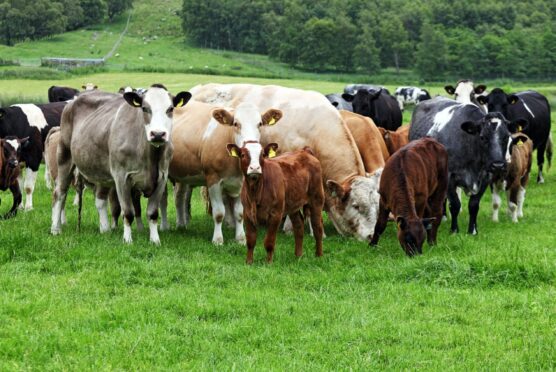It’s been a late spring as a result of some very changeable weather the past few months.
At last, we’re starting to see stock turned out to grass, albeit a little later than usual.
With the increasing temperatures grass growth is starting to come away now, but it’s important to remember that the nutrients available can vary greatly.
These nutrients fluctuate as the mineral content in soils differ across Scotland depending on the area and soil type.
Insufficient minerals can result in losses in herd performance as well as clinical deficiencies, both of which will reduce overall profitability.
Traditionally, many beef and suckler farms will look to mineral supplements throughout summer grazing to ensure these nutrients are supplied and nutritional needs are met.
Providing access to minerals through “free-access” buckets helps to balance any deficiencies in grazing. Calcium, Magnesium and Copper, along with Selenium and Vitamin E are the most commonly deficient in cattle throughout Scotland.
Subclinical deficiencies of these are often exhibited through reduced pregnancy rates, retained placentas, hoof issues, rough/discoloured hair coats and poor calf performance.
Looking for a supplement which will balance your forage and provide the correct levels of vitamins and minerals will boost overall herd health and fertility.
Calcium is essential for normal bone growth in young cattle, reducing any risk of stunted growth and development.
In older calving cows a Calcium deficiency can result in Milk Fever (Hypocalcaemia) due to the blood calcium concentration being too low.
Providing suckler cows with a good source of Calcium can also maximise fertility. Magnesium is vital to reduce the risk of Grass Staggers, caused by magnesium deficiency.
The flush of new grass growth at both this time of year, and in early autumn, can increase this risk as any new growth is often low in Magnesium. Supplementing Magnesium at turn-out will help cattle adjust from forage-based rations onto lush grazing, reducing any growth checks or health damage.
Copper deficiency can dramatically impact growth rates in both growing and finishing cattle.
Low levels can also lead to a thin, sparse, discoloured hair coat, as well as lameness and diarrhoea in both young and old cattle.
A deficiency can also impact herd fertility as low copper can reduce oestrus behaviour and ovulation, particularly in heifers.
Selenium and Vitamin E are important for both growth and performance. These play a key complimentary role in protecting cells from damage in youngstock. If deficient this can result in weak or damaged muscles impacting growth, especially after increased exercise at turn-out.
Herd performance is also affected by Selenium and Vitamin E. They are both important in improving conception rates and boosting the chances of embryo survival, increasing overall herd fertility.
High levels in supplementation will boost cattle health through an improved immune system and is vital for improving survival rates and vigour of new-born calves.
Many farms across Scotland will have ground which is naturally low in some vital minerals or trace elements, and mineral supplementation will be key to improving herd performance throughout the summer and, in turn, increasing overall profitability.
Taking both soil and grass samples to test for these levels can help determine which supplements are needed to best balance grazing.
At East Coast Viners, we have a wide range of mineral supplements, in both molassed bucket and powder form, which are designed to suit a variety of grazing systems, or bespoke minerals can be made, if required, in order to help you balance any major deficiencies at grass.
We’ll be out and about at the shows over the next few weeks, so if you have any areas you are looking to improve or are curious about different ways of boosting productivity, make sure you drop into the stand to see us.











